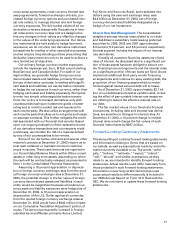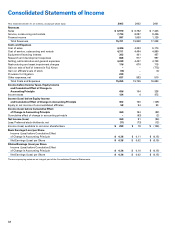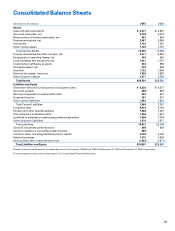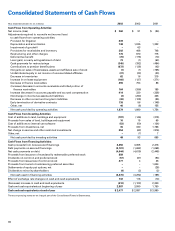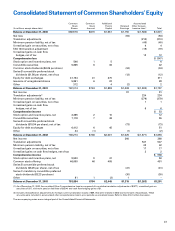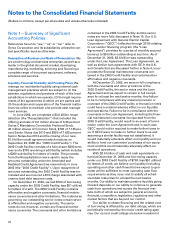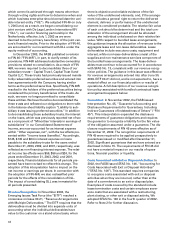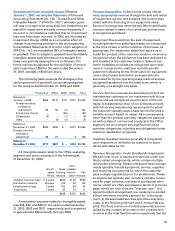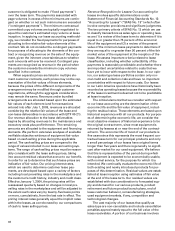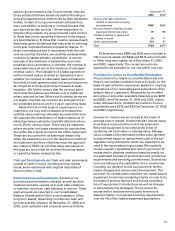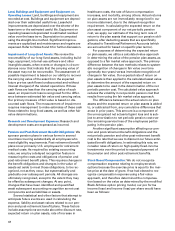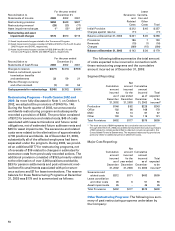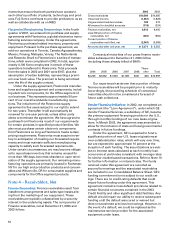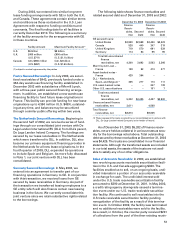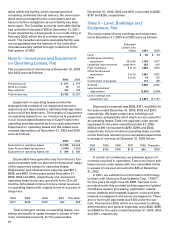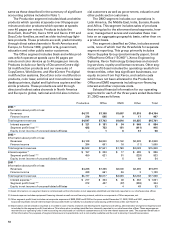Xerox 2003 Annual Report Download - page 49
Download and view the complete annual report
Please find page 49 of the 2003 Xerox annual report below. You can navigate through the pages in the report by either clicking on the pages listed below, or by using the keyword search tool below to find specific information within the annual report.
47
sales to governmental units. Governmental units are
those entities that have statutorily defined funding or
annual budgets that are determined by their legislative
bodies. Certain of our governmental contracts may
have cancellation provisions or renewal clauses that
are required by law, such as 1) those dependant on
fiscal funding outside of a governmental unit’s control,
2) those that can be cancelled if deemed in the taxpay-
er’s best interest or 3) those that must be renewed each
fiscal year, given limitations that may exist on entering
multi-year contracts that are imposed by statute. In
these circumstances and in accordance with the rele-
vant accounting literature, we carefully evaluate these
contracts to assess whether cancellation is remote
because of the existence of substantive economic
penalties upon cancellation or whether the renewal is
reasonably assured due to the existence of a bargain
renewal option. The evaluation of a lease agreement
with a renewal option includes an assessment as to
whether the renewal is reasonably assured based on
the intent of such governmental unit and pricing terms
as compared to those of short-term leases at lease
inception. We further ensure that the contract provi-
sions described above are offered only in instances
where required by law. Where such contract terms are
not legally required, we consider the arrangement to
be cancelable and account for it as an operating lease.
Aside from the initial lease of equipment to our
customers, we may enter subsequent transactions
with the same customer whereby we extend the term.
We evaluate the classification of lease extensions of
sales-type leases using the originally determined eco-
nomic life for each product. There may be instances
where we enter into lease extensions for periods that
are within the original economic life of the equipment.
These are accounted for as sales-type leases only
when the extensions occur in the last three months of
the lease term and they otherwise meet the appropri-
ate criteria of SFAS 13. All other lease extensions of
this type are accounted for as direct financing leases
or operating leases, as appropriate.
Cash and Cash Equivalents: Cash and cash equivalents
consist of cash on hand, including money-market
funds, and investments with original maturities of
three months or less.
Restricted Cash and Investments: Several of our
borrowing and derivative contracts, as well as other
material contracts, require us to post cash collateral
or maintain minimum cash balances in escrow. These
cash amounts are reported in our Consolidated
Balance Sheets within Other current assets or Other
long-term assets, depending on when the cash will
be contractually released. At December 31, 2003 and
2002, such restricted cash amounts were as follows:
December 31,
2003 2002
Escrow and cash collections
related to secured borrowing
arrangements $462 $349
Escrow related to liability to trusts
issuing preferred securities 79 155
Collateral related to swaps and
letters of credit 74 77
Other restricted cash 114 97
Total $729 $678
Of these amounts, $386 and $263 were included in
Other current assets and $343 and $415 were included
in Other long-term assets, as of December 31, 2003
and 2002, respectively. The current amounts are
expected to be available for our use within one year.
Provisions for Losses on Uncollectible Receivables:
The provisions for losses on uncollectible trade and
finance receivables are determined principally on the
basis of past collection experience applied to ongoing
evaluations of our receivables and evaluations of the
default risks of repayment. Allowances for doubtful
accounts on accounts receivable balances were $218
and $282, as of December 31, 2003 and 2002, respec-
tively. Allowances for doubtful accounts on finance
receivables were $315 and $324 at December 31, 2003
and 2002, respectively.
Inventories: Inventories are carried at the lower of
average cost or market. Inventories also include equip-
ment that is returned at the end of the lease term.
Returned equipment is recorded at the lower of
remaining net book value or salvage value. Salvage
value consists of the estimated market value (general-
ly determined based on replacement cost) of the sal-
vageable component parts, which are expected to be
used in the remanufacturing process. We regularly
review inventory quantities and record a provision for
excess and/or obsolete inventory based primarily on
our estimated forecast of product demand, production
requirements and servicing commitments. Several fac-
tors may influence the realizability of our inventories,
including our decision to exit a product line, techno-
logical changes and new product development. The
provision for excess and/or obsolete raw materials and
equipment inventories is based primarily on near term
forecasts of product demand and include considera-
tion of new product introductions as well as changes
in remanufacturing strategies. The provision for
excess and/or obsolete service parts inventory is
based primarily on projected servicing requirements
over the life of the related equipment populations.


